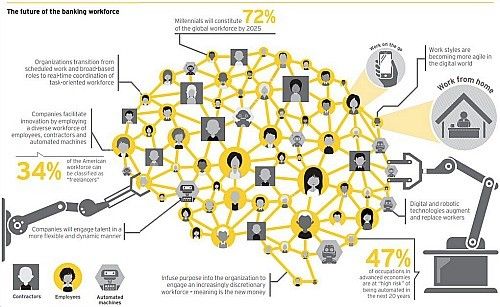Banks are doing everything to maintain their business in the digital era – and keep forgetting the human being at the heart of their business. A mistake.
Digital revolution, regulation, optimization: With these concepts at the forefront of the strategic thinking of banks, human beings, the employees of a bank, tend to be forgotten and ignored.
A mistake, according to experts of consultant Ernst & Young (EY): «Transforming talent is just as important to rebuilding a viable, successful banking franchise as transforming products and processes,» they conclude in the study titled «Transforming Talent – The Banker of the Future».
Disruptive Technologies
To ignore this fact was dangerous as banks will undergo fundamental change triggered by disruptive technologies. It would be fatal not to know who was actually in charge at a financial services institute in such a moment.
A couple of thoughts are helpful to understand the 'cloud' of factors (see below) influencing the workplace bank in future.

1. Understand How the New Generation Banker Works
By 2025, two thirds of a bank's workforce will be made up by people born between 1981 and 2000. To think that the «Generation Y» is only about lifestyle and consumption is simplistic. They, the millennials, are ready to swap jobs quickly once they realize that they aren't held in the right esteem or are underpaid. To keep their knowledge and their natural ease with technology at the bank, they have to be treated as small entrepreneurs with a say and with responsibility.
Banking is dominated by rigid hierarchies and extreme pressure on young bankers to perform.
2. Know, Which Jobs Are Needed
It is obvious that some types of jobs will disappear with the technological development. Under pressure will be employees in back offices and also at the front with customers, where robo advisers will assume part of the workload.
Analysts, advisers for the super rich and employees in call centers won't be replaced quickly though.
Banks will need more IT experts and banking process specialists, who understand software written half a century earlier.
Bankers need to create conditions enabling employees to log on from anywhere. The typical office workplace belongs to the past, the study authors claim.
3. The End of the Master of the Universe
The study paints a bleak picture of today's banking world. The industry is detached from demographic trends and has become a silo for careerist men fighting for the top job. This has affected innovation at the banks, which operate far away from the true needs of their customers.
To help solve the problem, banks need to employ more women. With less rigid career paths, women will also be able to access the higher echelons of power within the financial services industry. Managers need to promote talent irrespective of their gender. And managers need to become respected not because of the size of bonus but on how well they take care of their teams.
4. Accept that 'Hire and Fire' Mentality Is Dangerous
The problem with today's talents is that they don't move into banking anymore – technology firms have become more attractive. Banks are at a disadvantage if they don't find new arguments in favor of a career in banking. Part of making banks more attractive again is understanding that a 'hire and fire' policy is deeply unattractive for employees.
Employees need to get involved in a process, which will tie them to the company for the long term. Financial incentives, including stock options and bonuses ought to play smaller roles than today, according to the study authors. More important is to transfer responsibility, enhance the feedback culture and implement a more immediate appreciation of good performances.



























